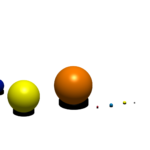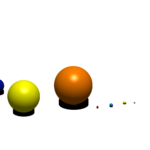
Technichal Specifications
How to use this exercise?
The model can be used to learn about the Solar system (Sun and planets), as well as to understand sizes and positions with respect to the Sun.
Number of pieces of this exercise
17
General description
This exercise is composed by 3D printed spherical models of the star (the Sun) and the eight planets (Mercury, Venus, Earth, Mars, Jupiter, Saturn, this one with external rings around it; Uranus and Neptune) that compose de Solar system. All of them will have a ring retainer underneath to prevent the rolling away.
The Sun is printed in a 1:5 000 000 000 scale from its real dimension and the planets in a 1:1 000 000 000 one.
Additional Material
Models used:
License Info
Attribution 4.0 International (CC BY 4.0) https://creativecommons.org/licenses/by/4.0/You are free to:
Share — copy and redistribute the material in any medium or format
Adapt — remix, transform, and build upon the material
for any purpose, even commercially.
Under the following terms:
Attribution — You must give appropriate credit, provide a link to the license, and indicate if changes were made. You may do so in any reasonable manner, but not in any way that suggests the licensor endorses you or your use.
No additional restrictions — You may not apply legal terms or technological measures that legally restrict others from doing anything the license permits.
Learning Specifications
How can the model be used in class?
With this model the teacher will be able to instruct the students about the Solar system by letting them to place the planets around the Sun, while he/she compares and comments about them.
What benefits can its use have?
The main benefit obtained from this model is to obtain the knowledge about our Solar system in a very visual and attracting way. The students will be able to manage all the different parts of the model, which improves the understanding.
A perception of the different sizes of the planets will be certainly obtained and also, since the dimensions of the printed models have been calculated with the specified reduction scale, the students could also practice their skills by measuring the pieces and comparing them with their real dimensions to obtain the engaged reduction scale.
Can it be used in other subjects?
– Geography
– Science
– Engineering

